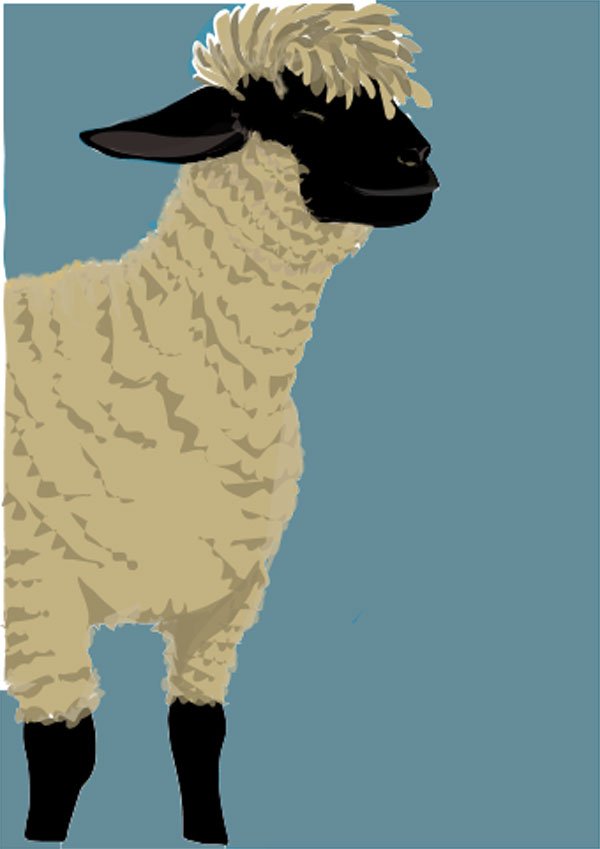The Wonderful Creatures of Mudchute Farm: Sheep
Sheep
Anyone who has seen Sheep grazing in fields knows that they are constantly munching away at the grass, looking a little bit like white clouds on a sky of green grass. The British countryside has been land formed by thousands and thousands of sheepy teeth nibbling away at the grassy hills and valleys and hooves pressing gently into the earth millions of times over hundreds of years.
Sheep are important to farmers in two ways. Some humans eat the meat of the lambs, young sheep, and the older animals, which is called mutton.

Sheep also grow beautiful thick coats of wool which, if it isn’t cut, like our hair, will go on growing and growing forever.
This is to protect them from life outdoors in the cold and the wet and the wind. This coat has a natural waterproofing called lanolin. Their fleece can be shaved off once a year at the end of winter, when it gets to be about 6 inches thick.
After it is cut the fleece, wool, is combed and spun and woven or knitted into clothes to keep humans warm. A lamb has to be about a year old before it is first shaved or shorn. These young sheep are called shearlings.

When they are first born some farmers put rings on the lambs tails.
Eventually the tails will fall off. Farmers do this is to prevent the animals getting something rather nasty called fly strike around their bottoms.
They can get bugs and ticks in their fleeces and you may sometimes see a magpie or other bird standing on the sheep’s back and picking out intruders.
We all need good neighbours like that
 When they are first born some farmers put rings on the lambs tails. Eventually the tails will fall off. Farmers do this is to prevent the animals getting something rather nasty called fly strike around their bottoms. They can get bugs and ticks in their fleeces and you may sometimes see a magpie or other bird standing on the sheep’s back and picking out intruders. We all need good neighbours like that.
When they are first born some farmers put rings on the lambs tails. Eventually the tails will fall off. Farmers do this is to prevent the animals getting something rather nasty called fly strike around their bottoms. They can get bugs and ticks in their fleeces and you may sometimes see a magpie or other bird standing on the sheep’s back and picking out intruders. We all need good neighbours like that.

Sheep are prey animals so even though they keep their heads down most of their lives to graze on the grass, at the same time they have to be on constant watch for other species that are going to try and eat them.
They have solved this problem by evolving amazing horizontal rectangular pupils that allow the between 270-320° vision so that they can spot any nastiness on the horizon almost all the way around them. (Imagine being able to see behind you)
This means that they can keep their eyes on the wide world at the same time as chewing the grass very close to the ground. Their mouths are very cleverly designed to do this job. Their top lip is split down the middle so they can pull it right back to get to the juicy new growth at the bottom of the blades of grass.
Like cows, they have no top front teeth and cut the grass with their lower teeth and tongue.

Sheep are very clever and sociable animals. They will lean against walls of trees so that their companions can jump onto their backs to reach tasty leaves or fruit. A ewe, that’s a female sheep, can recognise the bleating (voice) of her babies out of hundreds of other bleating Lambs. They can recognise up to 50 different sheep and human faces and remember them for at least 2 years. Amazingly they can also identify each other from photographs and even recognise human beings from photos as well. Experiments have been done with Farmers who have twins. If the non-Farmer twin dresses up in the Farmers clothes, the sheep can still tell the two of them apart.
When Sheep are happy they are very sociable and they wiggle their tails. When the are sad or poorly, they mope around by themselves and hang their heads.
In medieval times, wool was as valuable as gold, so everybody who had any land bought sheep and grazed them so that they could sell the fleeces for loads of money. Farmers made a lot of money from selling them to people who could make fantastic garments or blankets or yarn from them. Some incredible skills and crafts grew around the uses of wool which helped humans to be more comfortable as well as developing new technologies, if you can imagine knitting or crochet or weaving as a new technology! So all over England sheep were nibbling away at the hillsides and mountains and flat marsh land. Sheep evolved different qualities of wool and colouring to camouflage themselves and to keep warm and dry.
Farmers would breed sheep of one sort with sheep of another to get a perfect mixture of traits so that their flocks could thrive in each of the different habitats.

Places like Mudchute Farm are important these days because they nurture these ancient breeds of sheep and stop them from becoming extinct. Farmer Tom will tell you that the nibbling and trotting of these creatures shaped our countryside because wool was such a valuable commodity. Nowadays people are wearing clothes that are much more plasticky and the sheep’s coats are almost worthless, sometimes being sold for just a few pennies.
It feels very important that we should look after and value these beautiful creatures and care for them. They are a living part of our history.

